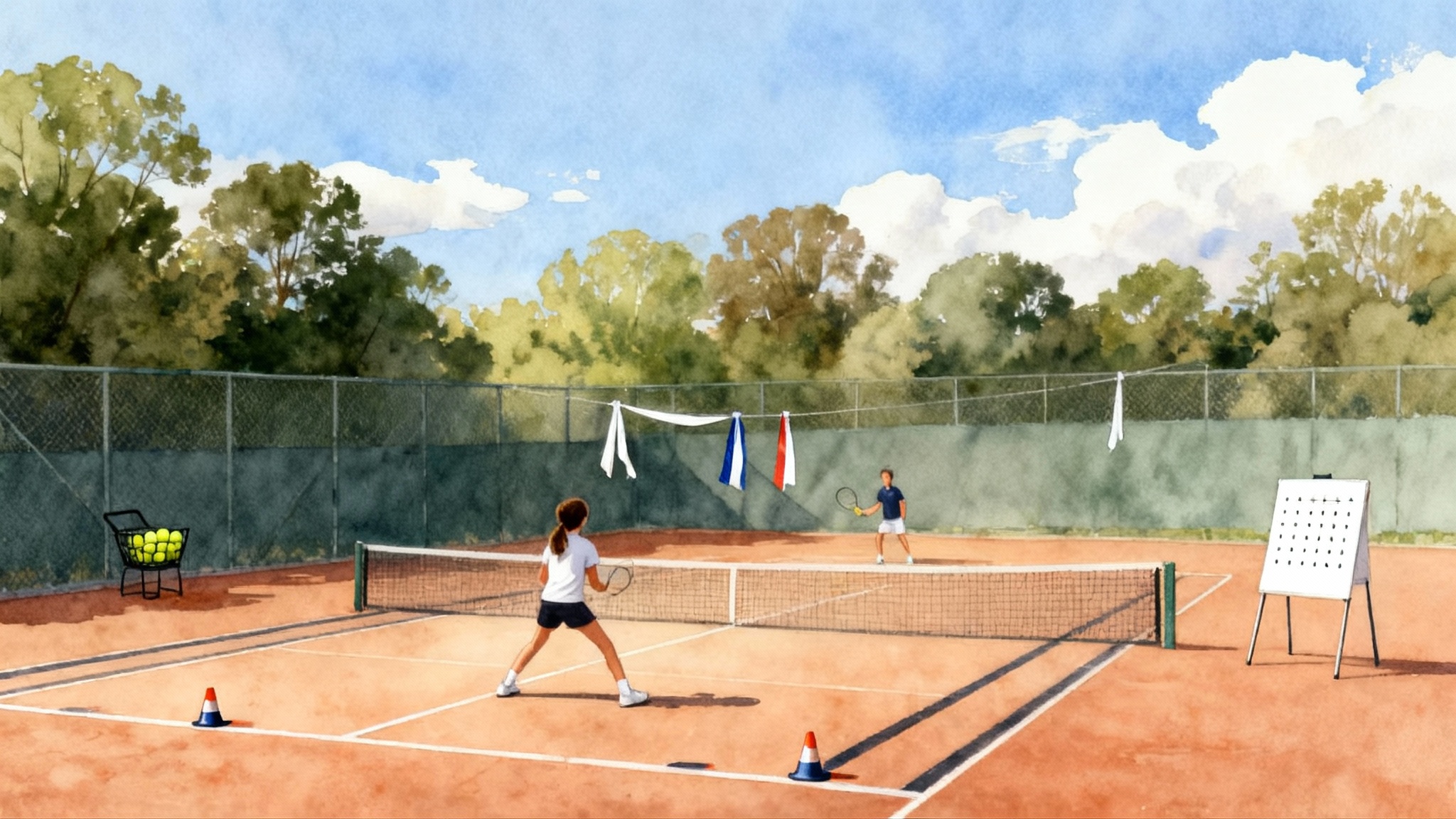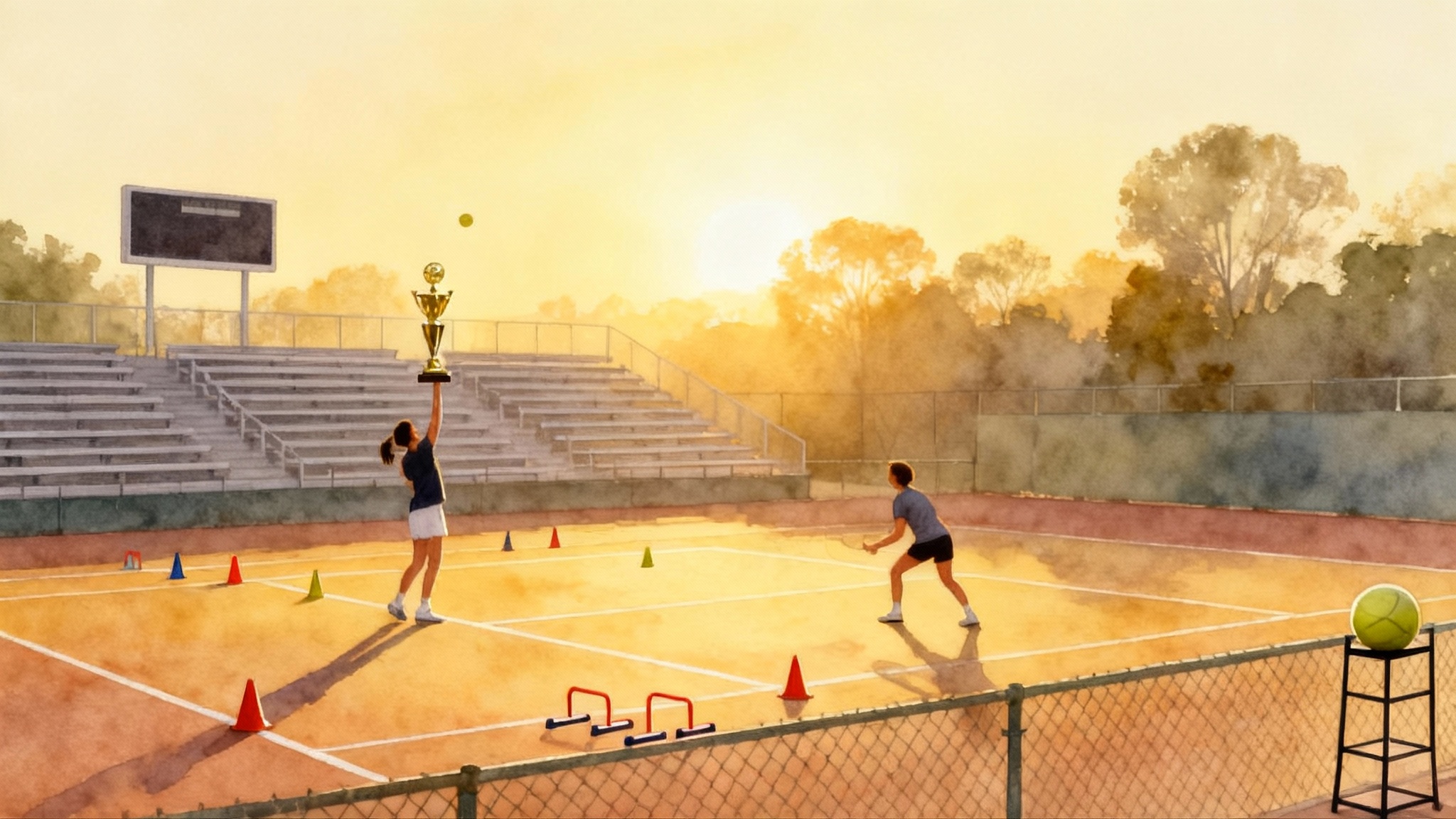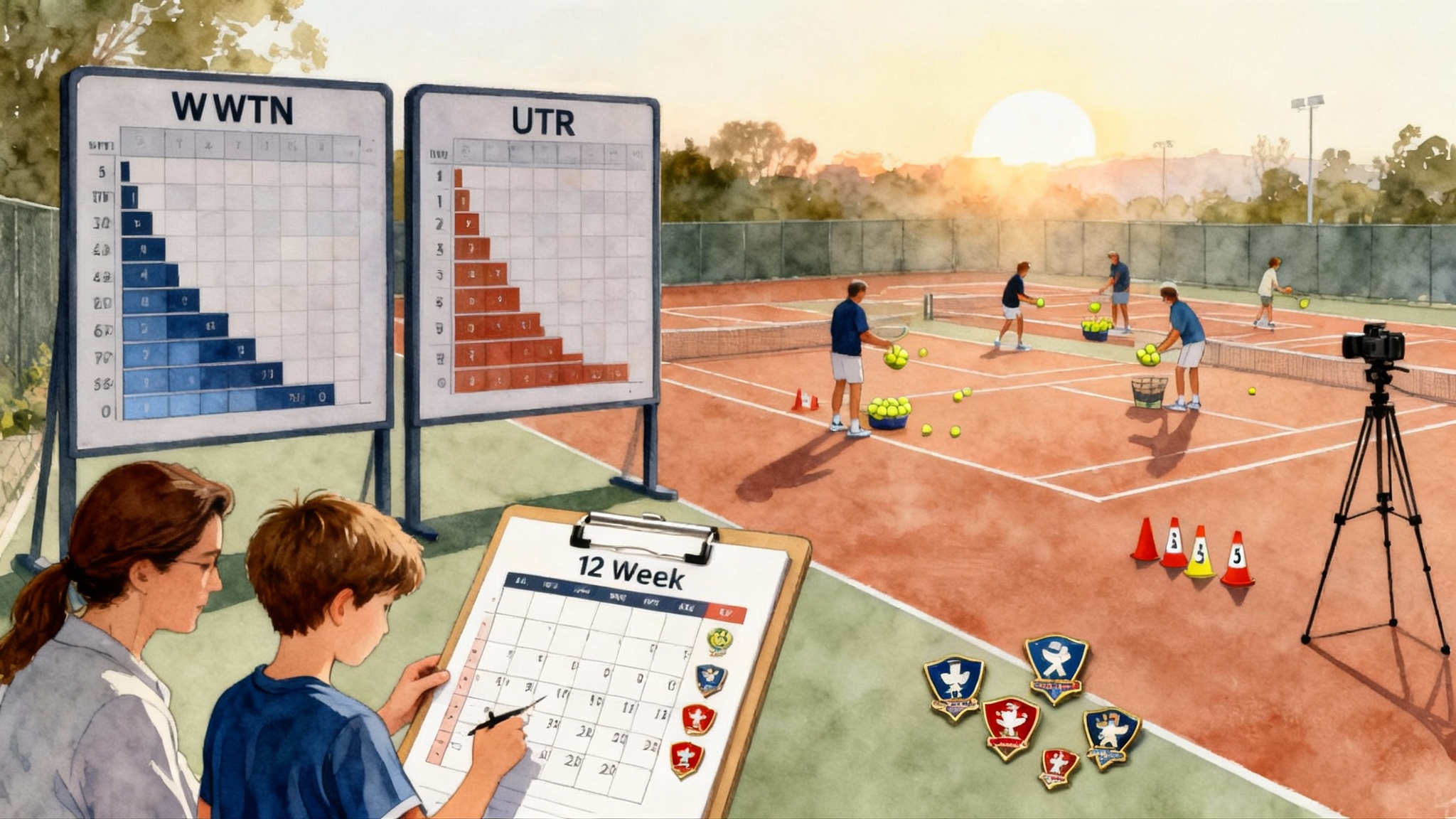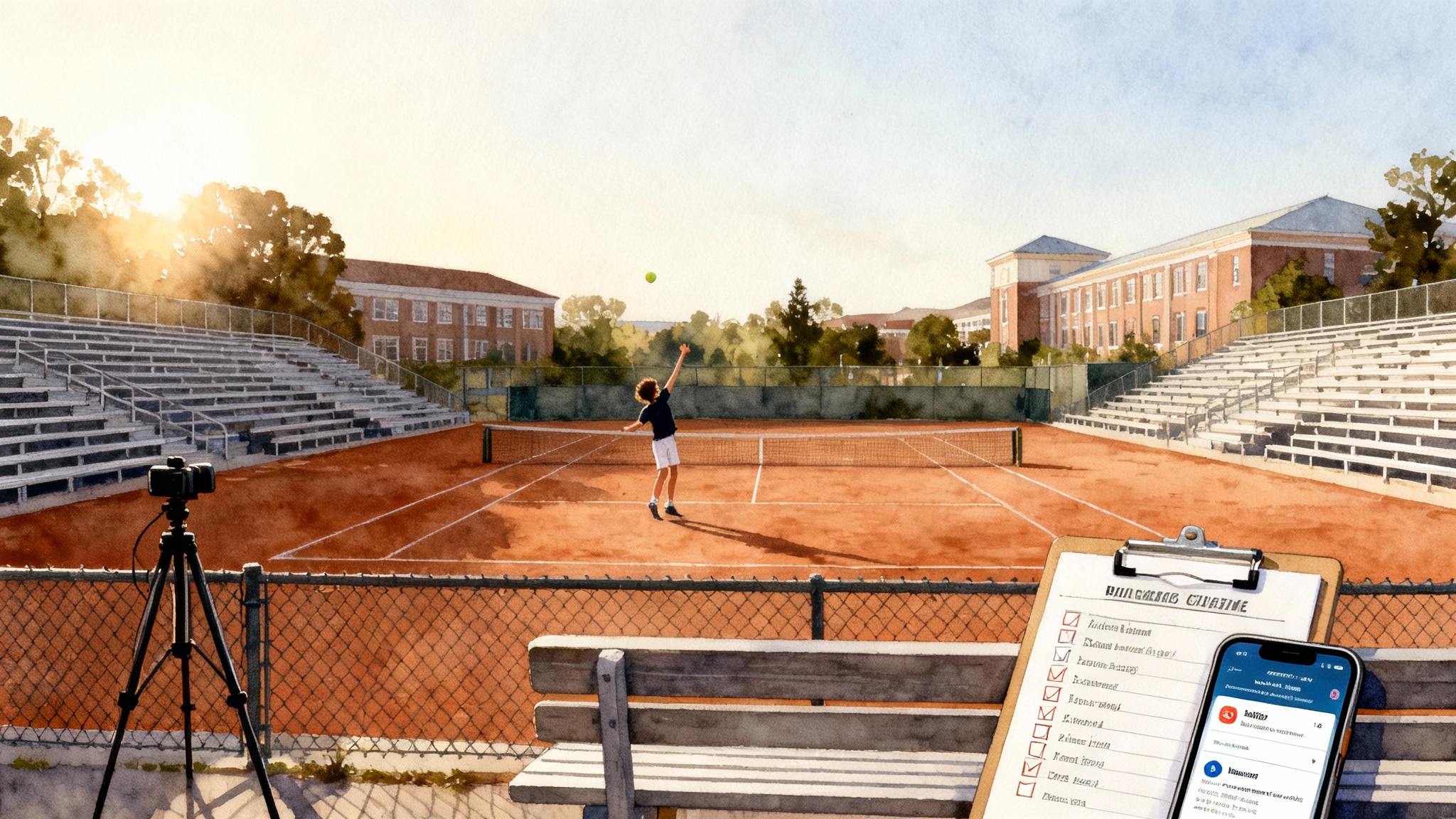Return of Serve Mastery: 4‑Week Plan for Juniors and Adults
Build a reliable return without overhauling your stroke. This four week plan grows anticipation, contact quality, and depth control with five on court progressions, at home drills, surface and doubles tweaks, plus trackable KPIs.

Why the return decides more matches than you think
Every rally you want to win must begin with a ball you can control. The goal of a world class return is simple and specific: read the server early, organize your body before the bounce, and send a heavy, deep reply that removes the server’s first play. You do not need a brand new swing. You need sharper anticipation, a tighter contact window, and dependable depth.
This guide gives you a four-week progression that juniors and adults can run with limited court time. You will train five on-court progressions in sequence, add simple at-home reaction drills, and track three clear key performance indicators so you know if it works. You will also see how to adapt on clay versus hard courts, set smart doubles return formations, and follow a printable weekly plan. We close with a mini case study from Austin Tennis Academy and a simple way to test with a coach.
The three pillars you will train
- Anticipation: your brain builds a picture before the ball leaves the strings. Reading toss height, shoulder turn, and rhythm gives you an early green light to move.
- Contact quality: think of a camera shutter. If the shutter opens at the right instant and stays steady, the picture is clear. Your return is that picture.
- Depth control: imagine a paint roller. You want to roll the ball through deep lanes, not splash paint short. Deep middle and deep cross are your highest value lanes.
What to measure before you start: your KPIs
Key performance indicators are simple numbers that tell you if practice transfers to matches. Use a friend, parent, or coach with a clipboard, or film on a smartphone and tally after.
- First serve return in-play percentage: 20 first serves to your deuce side and 20 to your ad side. Count how many returns land in the court. Target 60 percent for adult club players, 70 percent for advanced juniors, and keep climbing.
- Deep middle versus deep cross distribution: on a basket of 30 second serves, aim 15 to a deep middle cone and 15 to a deep cross cone. Track how many hit or pass the back cones. Target 60 percent or better beyond the cones by week four.
- Break point conversion on the return: in practice sets, mark each return game with a break point. Track how many you convert. Add pressure constraints in later weeks to move that number up.
Set a baseline on day one. You will test again at the end of week two and week four.
The five on-court progressions
You will work through these progressions inside the four-week plan. Each has setup, cues, and ways to scale for juniors and adults.
1) Recognition: read the server before the ball crosses the net
Setup
- Server hits normal first and second serves. Returner stands in match position.
- A coach or partner calls a pre-contact cue: “toss wide,” “toss into body,” or “toss up the T” as the server lifts the ball.
Cues
- Eyes on the shoulder and hitting elbow during the toss rise.
- Split step in sync with contact. Think bounce on their hit. For deeper work on timing, study split-step timing made simple.
- First move is a small hop and pivot, not a big step.
Scaling
- Juniors: use colored wristbands on the server. Green means wide, red means body, blue means T. Call color at the top of the toss to train early read.
- Adults: the server varies tempo. You adjust split timing without rushing the swing.
Scoring
- 10 ball sets. 1 point if you call the serve direction correctly before the hit, 1 point if you put the return in play. Track both columns.
2) Unit turn and set: organize your body faster than the ball
Setup
- Place a short elastic band around your forearms, just above the wrists. This keeps your elbows in and promotes a compact unit turn.
- Return only to targets, no points yet.
Cues
- Racquet and shoulders turn together as the ball leaves the server’s strings.
- Heel to toe split, then a one step plant and swing. Compact, connected, quiet.
Scaling
- Juniors: place a coin under the back heel. The coin should drop on the split, not before.
- Adults: serve speed escalates through the set. You keep the same quiet shape.
Scoring
- 20 serves. Give yourself a check mark if the return shape was compact and you hit a target. Do not overthink mechanics. Organize, then swing.
3) Contact window: meet the ball in a small, repeatable zone
Setup
- Hang two short ribbons from the net tape at hip height, three feet to either side of the center strap. These form a window for your ball to pass through.
- Server delivers mixed serves while you focus on where your contact happens, not how it looks.
Cues
- Picture the camera shutter. See the ball early, then freeze your head during contact.
- Keep your hitting elbow in front of your belly button at contact. This encourages a forward contact instead of a reach behind you.
Scaling
- Juniors: use foam balls for the first 10 serves to exaggerate feel and centered contact.
- Adults: limit backswing with a towel trapped under the back armpit for five ball bursts.
Scoring
- 3 sets of 10 serves. Mark a star if your ball travels through the ribbon window and lands deep. Review video if possible for head stillness.
4) Depth bands: roll the ball through lanes, not at the lines
Setup
- Lay two flat cones three feet inside each baseline, one in the middle third and one in the crosscourt third. These are your depth bands.
Cues
- Think paint roller. Brushing through the back of the ball, extend toward the band.
- Aim body lines for the middle band under stress, move to cross when you have time.
Scaling
- Juniors: award two points for a ball that lands beyond the cones and stays in the lane.
- Adults: the server calls your lane mid toss, you must adjust target without changing swing length.
Scoring
- 30 second serves, alternate lanes. Track beyond band percentage for each lane.
5) Patterned returns: win the first two shots
Setup
- Choose two patterns per side. Example on deuce side: deep middle return, then backhand up the line on the next ball. Example on ad side: deep cross return, then forehand cross again behind the server.
Cues
- Name your pattern out loud before the serve. Commit to the first two shots.
- Between points, breathe, walk back, and choose again. Keep tempo consistent.
Scaling
- Juniors: start patterns only on second serves, then mix.
- Adults: add point play to seven, but only a point counts if you called the pattern first.
Scoring
- Tally pattern completion rate. A pattern counts only if the return and the serve plus one land where you chose.
At-home reaction drills that actually transfer
These drills are short, safe, and build the same skills you need on court.
- Toss and step: stand three meters from a wall. A partner drops a ball from shoulder height. As the ball leaves the hand, hop a small split step and catch on the short hop with your hands in front. Three sets of 15, both sides.
- Flashlight go: partner aims a small light at the floor and clicks it on at random intervals. You split on the click and take one explosive step left or right. Ten clicks per set, three sets.
- Number call: toss a ball off the wall and call the number your partner shows with their fingers as you catch. This trains early focus and quiet head.
- Metronome split: set a metronome to the server’s rhythm you struggle with. Split on the beep, then shadow a compact unit turn and step. Two minutes, twice a day.
- Towel trap: hold a towel under your back armpit and shadow 20 returns. This keeps your shape compact and connected.
Keep each drill under six minutes. Short and frequent beats long and rare.
Clay versus hard court adaptations
Clay court adjustments
- Return position: start one to two feet deeper to allow for kick and higher bounce.
- Targeting: bias deep middle to shrink angles and make the server hit an extra ball.
- Footwork: think slide to load, not slide to stop. Slide into the plant, then recover.
Hard court adjustments
- Return position: start on or just behind the baseline, especially on second serves.
- Targeting: move earlier to deep cross to stretch the server off the deuce corner.
- Footwork: shorter and quicker split, one step plant, and recover on a straight line.
If you play on both surfaces in the same week, keep your rituals identical. Only change your starting position and your preferred lane.
Doubles return formations that tilt the odds
Returner and partner can set simple traps that produce easy first volleys.
- Standard formation, deep middle: aim through the middle lane beyond the depth band. This forces confusion and gives your partner a poach window.
- Australian formation: server’s partner and server line up on the same side. As the returner, aim heavy cross through the open lane or throw a lob down the line when the net player pinches too soon.
- I formation: server and partner start near the center. Call your target with hand signals before the point. Most club opponents leave the deep middle open. Pick it until they adjust.
- Second serve squeeze: both returner and partner take one step forward before contact. On a short second serve, attack through the body of the net player or dip the ball at their feet.
Keep signals simple. One finger means cross. Two fingers means middle. Thumb means lob. Agree on who covers what after the return so there are no collisions.
A mini case study from Austin Tennis Academy
Austin Tennis Academy has long embraced a constraints-led approach, where the task and environment shape the solution rather than long technical lectures. Here is a composite session drawn from that style that you can copy.
Athlete: 14-year-old girl, right handed, strong backhand. Goal: lift first serve return in-play percentage from 58 to 68 and push deep middle beyond band to 65 percent.
Block 1, recognition, 12 minutes
- Server mixes locations with three toss heights. Coach calls the toss height early. Athlete calls direction by the top of the toss. Score one point for correct call, one point for ball in play.
Block 2, unit turn and set, 10 minutes
- Elastic band around forearms. Five ball bursts at increasing speed. Cue is hips and shoulders move together, then a one step plant.
Block 3, contact window, 10 minutes
- Ribbons create the window. Head stillness is the only technical cue. Athlete watches a single point on the ball.
Block 4, depth bands and pattern, 15 minutes
- Cones mark deep middle and deep cross. Pattern named out loud before each serve: deuce side deep middle into backhand up the line, ad side deep cross into forehand cross.
Scoring and transfer
- After each block, they record quick percentages on a whiteboard. To close, they play a first to seven return game where only points started with a called pattern count. The athlete finishes at 66 percent first serves returned in play and 63 percent beyond the deep bands, then carries that confidence into weekend matches.
What to notice
- No one talked about the backswing shape for more than ten seconds. The environment drove the correct movement. The athlete left with numbers, not adjectives.
The four-week plan you can print
Each session is about 45 minutes. If you have less time, cut total reps but keep the order. If you have more time, add a short point play finisher.
Week 1, recognition and organization
- On court A, 2 sessions
- Warm up, five minutes of split timing with shadow swings
- Progression 1, recognition, 15 minutes
- Progression 2, unit turn and set, 15 minutes
- Finisher, 10 first serves each side, tally in play
- At home B, 2 sessions
- Toss and step, three sets of 15
- Metronome split, two minutes
- Towel trap, 20 shadows
- KPI checkpoint: baseline numbers recorded
Week 2, contact window focus
- On court A, 2 sessions
- Progression 3, contact window with ribbons, 20 minutes
- Progression 2 refresh, 10 minutes
- Depth bands intro, 10 minutes
- At home B, 2 sessions
- Flashlight go, three sets of 10
- Number call, three sets of 12
- KPI checkpoint: retest first serve return in-play percentage and beyond band percentage
Week 3, depth bands in earnest
- On court A, 2 sessions
- Progression 4, depth bands, 25 minutes
- Progression 1 refresh with faster servers, 10 minutes
- Pattern rehearsal on second serves, 10 minutes
- At home B, 2 sessions
- Metronome split, two minutes
- Towel trap, 20 shadows
- Toss and step, two sets of 12
Week 4, patterned returns and match transfer
- On court A, 2 sessions
- Progression 5, pattern naming and execution, 25 minutes
- Doubles formations practice, 10 minutes
- Pressure ladder, break point games to seven, 10 minutes
- At home B, 1 session
- Flashlight go, three sets of 10
- Number call, two sets of 12
- KPI checkpoint: full retest on all three indicators and review video
Parent and adult player notes
- Parents can call colors or numbers, film from behind the baseline, and tally scores. Adults training alone should place cones, use self toss serves, and record on a simple tracker.
- Keep sessions short and crisp. Two focused sessions beat one marathon.
A simple tracking sheet you can copy
- First serve return in play: 40 attempts, tally makes, compute percentage. Write deuce and ad separately.
- Beyond depth band: 30 second serve returns, mark middle lane and cross lane makes beyond cones. Compute percentage for each.
- Break point conversion: each practice set, circle games where you reached break point. Put a check mark if you won that game. Compute conversion.
If your numbers stall, return to the earlier progression that addresses the limiter. If you miss reads, spend three sessions on recognition. If contact is off, run the ribbon window again.
Common problems and fast fixes
- Late split step: set a beeping metronome and split on the beep. In matches, key your split to the ball meeting the strings, not the toss.
- Big backswing under pressure: trap a towel under the back armpit for five ball bursts. The compact shape will return on its own during points.
- Everything lands short: raise your target. See the back fence behind the depth band and extend the racquet face through that window.
- Misses wide on wide serves: aim inside the court. Shift your aiming point a paddle width in from the sideline and drive through the back of the ball.
Ready to test with a coach
If you want a coach to run your numbers and build your two best return patterns, book a 45 minute return assessment with a nearby partner such as Austin Tennis Academy, or share your KPIs and session clips after a weekend using our 48-hour tennis recovery protocol to arrive fresh.
Final thoughts
There is nothing mystical about a great return. You read sooner, you set cleaner, you contact calmer, and you roll the ball through deep lanes more often. The five progressions give you a blueprint. The at-home drills keep the blueprint alive when you are not on court. The key performance indicators tell you, in plain numbers, whether your work is paying off. Keep the plan simple and the scoring honest, and your return will stop being a coin flip and start being a weapon by the end of week four.


